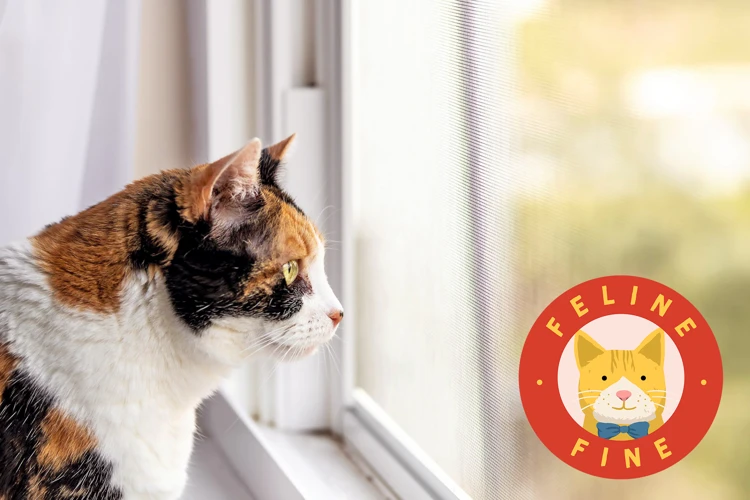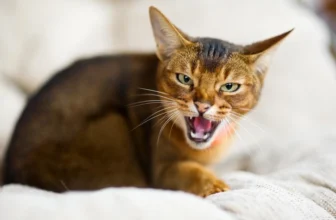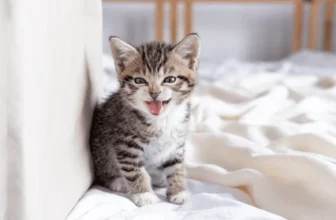It can be distressing to see your American Wirehair cat exhibit signs of separation anxiety. This is a common issue with pets, but it can be especially alarming when you’re dealing with a breed as unique as the American Wirehair. Separation anxiety can lead to destructive behavior and negative physical symptoms, so it’s important to understand what to look for and how to address the issue. In this article, we’ll dive into the ins and outs of separation anxiety in American Wirehairs and provide useful tips for identifying and dealing with it.
What is Separation Anxiety?

The dread of being away from their owners is a problem that many dogs face, and American Wirehairs are no exception. Separation anxiety is a condition in which dogs experience extreme anxiety and panic when their owners leave them alone. It can cause destructive behavior, excessive barking, and other disturbing symptoms in dogs. In this section, we will delve deeper into what separation anxiety is, its common symptoms, and the possible causes. If you want to learn more about preventing and managing separation anxiety in American Wirehairs, continue reading.
Symptoms of Separation Anxiety
One of the most challenging aspects of being a pet parent is figuring out whether your furry friend is suffering from separation anxiety. Separation anxiety is a common problem that many American Wirehairs (and other cats) can face when left alone for too long. If you’re concerned that your American Wirehair might be suffering from separation anxiety, here are some symptoms to look out for:
- Excessive meowing: Does your American Wirehair meow excessively when you leave the house? This is a sign of anxiety.
- Destructive behavior: If your American Wirehair is scratching the furniture, chewing on cords, or tearing up the carpet when you’re not home, this may be a sign of separation anxiety.
- Going to the bathroom outside of the litter box: If your cat is fully trained to use the litter box but starts going to the bathroom elsewhere, this could be a way for your cat to express their anxiety.
- Aggressive behavior: If your American Wirehair is usually a friendly cat but starts hissing, biting, or scratching when you’re leaving or coming home, this is also a sign of anxiety.
- Excessive grooming: Cats generally groom themselves, but if your American Wirehair is excessively grooming themselves or over-grooming specific areas, this could be due to anxiety.
If your American Wirehair is showing any of these signs, don’t brush it off as just typical cat behavior. Separation anxiety is a serious issue that can lead to your cat experiencing extreme stress or depression. It’s vital to determine the causes of separation anxiety and take action to prevent it from occurring. Check out our article on preventing and managing separation anxiety in American Wirehairs to learn more about how to help your furry friend.
Causes of Separation Anxiety
Separation anxiety is a complex issue that can stem from a variety of causes. Every American Wirehair is unique and as such, the reasons why they may feel stressed and anxious when left alone can differ. Here are some possible causes of Separation Anxiety in American Wirehairs:
- Change in Routine: Dogs thrive on routine and when their daily routine changes, it can cause them stress and anxiety. For example, if you recently started a new job with different work hours, your American Wirehair may become anxious and upset because they are not used to being alone for extended periods of time.
- Lack of Socialization: Socialization is crucial for dogs and it’s important to expose them to different people, pets, and environments from a young age. If your American Wirehair did not receive proper socialization early on, they may become anxious when left alone or separated from their owner.
- Past Trauma: If your American Wirehair experienced past trauma, such as being abandoned or neglected, it can cause them to become anxious when separated from their owner.
- Genetics: Some breeds are more prone to Separation Anxiety than others, and American Wirehairs are no exception. If your American Wirehair comes from a line of dogs prone to anxiety, they may be more likely to develop Separation Anxiety.
- Medical Issues: In some cases, Separation Anxiety may be caused by an underlying medical issue, such as a thyroid problem.
It’s important to note that while these may be common causes of Separation Anxiety, every dog is different and there may be additional factors at play. If you suspect that your American Wirehair is suffering from Separation Anxiety, it’s important to consult with your veterinarian as they can help determine the best course of action to help your furry friend. Additionally, there are several tips and strategies that can help alleviate Separation Anxiety, such as medication, training and socialization, and regular exercise.
Tips for Coping with Separation Anxiety
Coping with separation anxiety in pets can be a challenge but thankfully, there are ways to manage it. Here are some tips to help you and your American Wirehair deal with this condition:
- Create a predictable routine: A routine can help reduce stress and anxiety in pets. Stick to the same feeding, walking, and playing times every day to help your pet feel more secure and confident.
- Provide plenty of exercise: Exercise helps to reduce stress levels and can keep your pet from feeling anxious. Make sure your American Wirehair gets plenty of exercise on a daily basis whether it’s playing fetch or going for a walk.
- Give your pet plenty of attention: When you’re home, make sure your pet gets plenty of attention and love. This helps your pet feel more secure and will keep separation anxiety at bay.
- Use toys and puzzles: Give your pet toys and puzzles to keep them occupied while you’re away. Puzzle toys can be particularly helpful since they keep your pet’s mind active and give them something to focus on.
- Consider pheromone products: Pheromone products like sprays or diffusers can help to calm pets who suffer from separation anxiety. These products mimic the calming pheromones that mother cats produce when they nurse their young.
- Avoid punishment: Punishing your pet for destructive or anxious behavior will only make matters worse. Instead, focus on positive reinforcement when your pet behaves well.
- Ask your veterinarian for advice: If your pet’s separation anxiety is severe, consider speaking to your veterinarian who can offer advice or medication to help manage the condition.
By implementing these tips, you can help your American Wirehair cope with separation anxiety and reduce the likelihood of destructive or anxious behavior. Remember, patience and consistency are key to helping your pet overcome this condition.
How to Identify Separation Anxiety in American Wirehairs

If you’re a pet owner, you know how heart-wrenching it can be to watch your furry friend suffer from separation anxiety. American Wirehairs, in particular, are highly affectionate cats that form strong bonds with their owners. It’s essential to recognize the signs of separation anxiety in American Wirehairs and help your pet cope with the condition. In this section, we’ll discuss how to identify separation anxiety in American Wirehairs using various behavioral and physical cues.
Destructive Behavior
One of the most common signs of separation anxiety in American Wirehairs is destructive behavior. If you come home to a destroyed house and your wirehair is the only one present during this time, it is likely that they are trying to cope with being left alone. Some examples of destructive behavior include:
- Chewing on furniture, shoes, or personal belongings
- Digging at doors or windows to escape
- Scratching or gnawing at surfaces like windowsills, doors, or walls
- Barking, whining, or howling for long periods of time
These actions can be extremely frustrating for pet parents, but it’s important to remember that your furry friend is not acting out of spite. They are just trying to soothe their anxiety in any way they know how. If left unaddressed, this behavior can cause harm to your dog and damage to your home.
If you suspect that your American Wirehair is experiencing separation anxiety, it’s important to address the issue as soon as possible to prevent further destruction.
Anxious Behavior
American Wirehairs with separation anxiety may exhibit anxious behaviors when they are left alone. These behaviors can be subtle or more obvious, but it’s important to recognize them as signs of anxiety so you can help your cat feel more secure. Here are some anxious behaviors to look out for:
| Anxious Behavior | Description |
|---|---|
| Excessive Meowing or Purring | When your American Wirehair is left alone, they may meow or purr excessively. This can be a way for them to try and comfort themselves or seek attention from their owner. |
| Isolation or Hiding | If your cat retreats to a hiding spot when you’re leaving the house, it could be a sign of anxiety. This behavior allows your cat to feel more secure and protected, but it can also make it difficult for you to track their behavior. |
| Excessive Licking or Grooming | Some cats may groom themselves excessively when they feel anxious. This behavior is a way for them to soothe themselves and relieve stress. |
| Scratching | American Wirehairs may scratch excessively when they’re feeling anxious. This is a way for them to relieve tension and frustrate their feelings. |
| Change in Appetite or Elimination Habits | Cats with separation anxiety may have difficulty eating or using the litter box consistently while their owners are out. They may eat less food or refuse to use the litter box altogether. This can lead to health problems, so it is important to monitor your cat’s eating and elimination habits. |
If you observe these anxious behaviors in your American Wirehair, it’s important to take steps to help them feel more at ease and improve their emotional health and well-being.
Physical Symptoms
American Wirehairs with separation anxiety may exhibit various physical symptoms that indicate their stress and distress. These symptoms may include both behavioral changes and physical ones. Here are some of the most common physical symptoms of separation anxiety in American Wirehairs:
| Physical Symptom | Description |
|---|---|
| Excessive Panting | American Wirehairs may breathe harder and faster than usual due to their anxiety and nervousness. |
| Trembling or shaking | Their bodies may shake or tremble due to the stress and anxiety they experience when left alone. |
| Loss of appetite | In some cases, separation anxiety can lead to a loss of appetite, as the American Wirehair may feel too anxious to eat. |
| Excessive grooming or scratching | Some American Wirehairs may excessively groom or lick themselves when they are anxious. |
| Urinating and defecating in inappropriate places | Separation anxiety can cause American Wirehairs to have accidents inside the home, even if they are typically house-trained. |
| Escaping or trying to escape the home or crate | American Wirehairs may try to scratch, dig, or chew their way out of their crate or attempt to escape the home in search of their owner when they are feeling anxious and alone. |
If you notice any of these physical symptoms in your American Wirehair, it’s important to address the underlying cause of their anxiety and seek help. Your veterinarian or a professional animal behaviorist can help you develop a plan to manage your furry friend’s separation anxiety and improve their overall well-being. Don’t ignore these symptoms, as they can worsen over time and lead to more serious health problems for your pet.
How to Help Your American Wirehair
As a pet parent, it can be tough to see your American Wirehair struggle with separation anxiety. However, there are several ways to help your furry friend cope with this condition. From training and environmental changes to supplements and medication, there are many options to explore. Let’s dive into some effective ways to support your American Wirehair through their separation anxiety journey.
Training and Socialization
American Wirehairs are intelligent cats, and proper training and socialization can go a long way in helping them cope with separation anxiety. Here are some tips on how to train and socialize your American Wirehair:
1. Start training early: Start training your American Wirehair as soon as possible, preferably when they are kittens. This will help them develop good habits and behaviors at an early age.
2. Positive reinforcement: Use positive reinforcement techniques, such as treats and praise, to reward your cat for good behavior. Avoid punishment-based techniques as they can cause more anxiety and stress in your cat.
3. Socialization: Socializing your American Wirehair with other cats and people can help them become more comfortable with different environments and situations. Make sure to introduce them to new experiences gradually and in a positive manner.
4. Interactive playtime: Engage in interactive playtime with your cat to establish a bond and reduce their anxiety. Play with toys that encourage physical activity and mental stimulation.
5. Consistency: Be consistent with your training and socialization efforts. A routine and predictable environment can help reduce stress and anxiety in your cat.
It’s important to remember that every cat is unique and may require different training and socialization approaches. Consult with a veterinarian or professional cat behaviorist if you are having trouble managing your cat’s separation anxiety.
Environmental Changes
Making environmental changes can have a positive impact on a cat’s separation anxiety. Here are some suggestions:
- Provide a Safe Space: Cats need their own space, where they can feel safe and secure. This space should have comfortable bedding, toys, scratching posts, and access to food and water. Make sure to keep this space consistent, and avoid moving it around too often.
- Leave Distractions: Provide your cat with toys or puzzles that will keep them occupied while you’re away. Puzzle feeders and toys filled with catnip can be especially helpful. You can also leave a radio or TV on, which can provide some background noise and make your cat feel less alone.
- Get a Companion: Consider adopting another cat as a companion for your American Wirehair. Having a feline friend can provide social interaction and help reduce anxiety. However, it’s important to make sure the cats get along before leaving them alone together.
- Use Feliway: Feliway is a pheromone spray that can help reduce stress and anxiety in cats. You can spray it in your cat’s safe space or in areas where your cat spends a lot of time.
- Keep a Routine: Consistency is key when it comes to reducing separation anxiety. Try to keep a consistent routine for feeding, playtime, and bedtime. This will help your cat feel more secure and less anxious.
Keep in mind that every cat is unique, and what works for one might not work for another. If you’re having trouble managing your cat’s separation anxiety, consider consulting with a veterinarian or animal behaviorist for personalized advice and guidance.
Supplements and Medication
Supplements and medication have been shown to be effective in treating separation anxiety in American Wirehairs. Before giving your cat any medication, it’s important to consult with a veterinarian. Here are some supplements and medications that can help alleviate separation anxiety:
- L-theanine: An amino acid found in tea leaves, L-theanine has been shown to promote relaxation and reduce anxiety in cats. It can be given in supplement form.
- B-complex vitamins: B vitamins, particularly B12, can have a calming effect on cats and help reduce stress.
- Probiotics: Probiotics can help promote digestive health and reduce inflammation, which can in turn help with anxiety.
- Prescription medication: In severe cases, prescription medication may be necessary. Your veterinarian may prescribe antidepressants or anti-anxiety medication to help alleviate your cat’s symptoms.
It’s important to note that medication alone is not a cure for separation anxiety. It should be used in conjunction with behavior modification techniques and environmental changes. Your veterinarian can help you determine the best course of treatment for your American Wirehair.
Conclusion
As a pet owner, it can be heartbreaking to see your American Wirehair suffering from separation anxiety. However, with the right knowledge and tools, you can help your feline friend cope and improve their quality of life.
Remember, separation anxiety is a common issue and is not a reflection of your pet’s behavior or your abilities as an owner. By recognizing the signs of separation anxiety, identifying the root causes, and implementing the right strategies and techniques, you can make a significant difference in your pet’s life.
If you suspect that your American Wirehair is suffering from separation anxiety, it’s essential to consult with a veterinarian or animal behaviorist. They can provide professional advice and guidance on the best course of action for your pet’s specific needs.
Although it may take time and patience, there are many effective ways to help your pet overcome separation anxiety. By providing a stable and supportive environment, engaging in positive reinforcement, and seeking specialized assistance as needed, you can help your American Wirehair live a happy, healthy, and fulfilling life.
Remember to always show your pet love and understanding, even during their most challenging moments. With your help and support, your American Wirehair can overcome separation anxiety and thrive as a beloved member of your family.
Frequently Asked Questions
What age range is most susceptible to separation anxiety in American Wirehairs?
Separation anxiety can occur in American Wirehairs of any age, but it is most common in younger dogs.
Can separation anxiety be prevented in American Wirehairs?
While there is no surefire way to prevent separation anxiety, proper training and socialization can help reduce the risk.
Do American Wirehairs with separation anxiety always exhibit destructive behavior?
No, not all dogs with separation anxiety exhibit destructive behavior. Some may show anxious behavior or physical symptoms instead.
Are certain American Wirehair colors more prone to separation anxiety?
There is no evidence to suggest that American Wirehair colors play a role in the development of separation anxiety.
Can medication cure separation anxiety in American Wirehairs?
Medication can help manage the symptoms of separation anxiety, but it is not a cure. It should be used in conjunction with behavior modification and training.
Is it possible for American Wirehairs to develop separation anxiety later in life?
Yes, dogs can develop separation anxiety at any age, although it is more commonly seen in younger dogs.
Does leaving the TV or radio on help American Wirehairs with separation anxiety?
Leaving the TV or radio on can provide some comfort to dogs, but it is not a substitute for proper training and management of separation anxiety.
Can American Wirehairs with separation anxiety benefit from having another dog in the household?
It is possible for another dog to provide comfort and security to a dog with separation anxiety, but it is not a guaranteed solution and each dog’s situation is unique.
Can separation anxiety lead to health problems in American Wirehairs?
Chronic stress and anxiety can have negative effects on a dog’s overall health, so it is important to address separation anxiety as soon as possible.
Is it possible to cure separation anxiety in American Wirehairs?
While there is no guarantee that separation anxiety can be fully cured, it can be managed through a combination of behavior modification, training, and possibly the use of medication or supplements.







